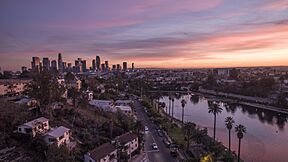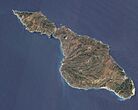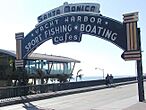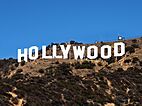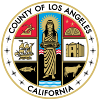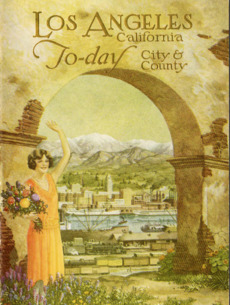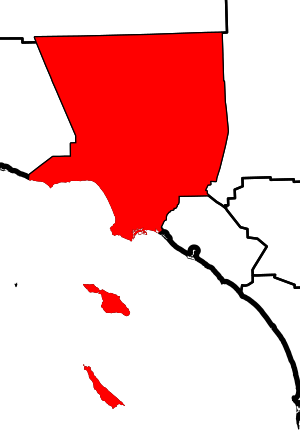Los Angeles County, California facts for kids
Quick facts for kids
Los Angeles County
|
|||||
|---|---|---|---|---|---|
|
|||||
| Nickname(s):
"LA County", "Metro-LA", "Greater LA"
|
|||||
| Country | United States | ||||
| State | California | ||||
| Region | Southern California | ||||
| Metro area | Greater Los Angeles | ||||
| Formed | February 18, 1850 | ||||
| Named for | Our Lady, Queen of the Angels | ||||
| County seat | Los Angeles | ||||
| Largest city | Los Angeles | ||||
| Incorporated cities | 88 | ||||
| Government | |||||
| • Type | Council–CEO | ||||
| • Body | Board of Supervisors | ||||
| Area | |||||
| • Total | 4,751 sq mi (12,310 km2) | ||||
| • Land | 4,058 sq mi (10,510 km2) | ||||
| • Water | 693 sq mi (1,790 km2) | ||||
| Highest elevation | 10,068 ft (3,069 m) | ||||
| Lowest elevation | 0 ft (0 m) | ||||
| Population
(July 1, 2023)
|
|||||
| • Total | 9,663,345 |
||||
| • Density | 2,430/sq mi (940/km2) | ||||
| GDP | |||||
| • Total | $961.908 billion (2023) | ||||
| Time zone | UTC−8 (Pacific Time Zone) | ||||
| • Summer (DST) | UTC−7 (Pacific Daylight Time) | ||||
| ZIP Codes |
90xxx–918xx, 92397, 92821, 92823, 93243, 935xx
|
||||
| Area codes | 213/323, 310/424, 442/760, 562, 626, 657/714, 661, 747/818, 840/909 | ||||
| FIPS code | 06-037 | ||||
| GNIS feature ID | 277283 | ||||
| Congressional districts | 23rd, 26th, 27th, 28th, 29th, 30th, 31st, 32nd, 34th, 35th, 36th, 37th, 38th, 42nd, 43rd, 44th, 45th | ||||
| Website | lacounty.gov | ||||
Los Angeles County, also known as LA County, is the county with the most people in the United States. In 2023, about 9.6 million people lived here. That's more people than in 40 different U.S. states!
LA County has 88 cities and many other areas. It covers about 4,083 square miles. More than a quarter of all Californians live here. It is also one of the most diverse counties in the U.S. The main city, Los Angeles, is the second largest city in the United States. It had about 3.8 million residents in 2023. Los Angeles County is famous worldwide for being the home of the U.S. movie industry. This has been true since movies first started in the early 1900s.
Contents
History of Los Angeles County
Los Angeles County was one of the first counties in California. It was created in 1850 when California became a state. The county was much bigger back then. It included parts of what are now Kern, San Bernardino, Riverside, Inyo, Tulare, Ventura, and Orange counties.
In 1851 and 1852, Los Angeles County stretched from the coast all the way to the state line of Nevada. As more people moved in, parts of the county were separated to form new counties. San Bernardino County was formed in 1853. Kern County was formed in 1866, and Orange County was formed in 1889.
Where is Los Angeles County?
Los Angeles County is located in Southern California.
It shares borders with several other counties:
- To the north: Kern County
- To the east: San Bernardino County
- To the southeast: Orange County
- To the south: The Pacific Ocean
- To the west: Ventura County
Geography and Nature
Los Angeles County covers a large area of about 4,751 square miles. Most of this area (85%) is land, and 15% is water. The county has about 70 miles of coastline along the Pacific Ocean. It also has mountains, valleys, forests, islands, lakes, rivers, and even some desert.
The main rivers flowing through Los Angeles County are the Los Angeles River, Rio Hondo, Ballona Creek, the San Gabriel River, and the Santa Clara River. The main mountain ranges are the Santa Monica Mountains and the San Gabriel Mountains. The western edge of the Mojave Desert starts in the Antelope Valley, which is in the northeastern part of the county.
Most people in Los Angeles County live in the southern and southwestern parts. Big cities are found in the Los Angeles Basin, San Fernando Valley, and San Gabriel Valley. Other populated areas include the Santa Clarita Valley, Pomona Valley, Crescenta Valley, and Antelope Valley.
The San Gabriel Mountains divide the county from west to east. These mountains are mostly part of the Angeles National Forest. Many of the county's highest peaks are in the San Gabriel Mountains. These include Mount San Antonio (10,068 feet tall), Mount Baden-Powell (9,399 feet tall), and Mount Wilson (5,710 feet tall).
Los Angeles County also includes two islands off the coast: San Clemente Island and Santa Catalina Island. These are part of the Channel Islands.
Lakes and Reservoirs
Los Angeles County has several lakes and reservoirs, which are important for water and recreation:
- Bouquet Reservoir
- Castaic Lake
- Crystal Lake
- Elizabeth Lake
- Hollywood Reservoir
- Malibou Lake
- Morris Reservoir
- Lake Palmdale
- Puddingstone Reservoir
- Pyramid Lake
- Quail Lake
- Silver Lake Reservoir
- Stone Canyon Reservoir
Major Areas of the County
The county is often divided into different regions:
- East: Eastside, San Gabriel Valley, parts of the Pomona Valley
- West: Westside, Beach Cities
- South: South Bay, South Los Angeles, Palos Verdes Peninsula, Gateway Cities, Los Angeles Harbor Region
- North: San Fernando Valley, Crescenta Valley, parts of the Conejo Valley, parts of the Antelope Valley and Santa Clarita Valley
- Central: Downtown Los Angeles, Mid-Wilshire, Northeast Los Angeles
Protected Natural Areas
Parts of Los Angeles County are protected natural areas:
- Angeles National Forest
- Los Padres National Forest
- Santa Monica Mountains National Recreation Area
Climate
The northern part of Los Angeles County has a Desert climate. Most of the rest of the county has a mix of semi-arid and hot-summer Mediterranean climate. This means it's often dry and sunny. Rain mostly falls in the winter. The mountains in the north-central part of the county get snow during winter.
People and Population
Los Angeles County is very diverse. It has people from many different backgrounds and cultures.
Population Growth Over Time
The population of Los Angeles County has grown a lot over the years:
- 1850: 3,530 people
- 1900: 170,298 people
- 1950: 4,151,687 people
- 2000: 9,519,338 people
- 2020: 10,014,009 people
- 2023: 9,663,345 people (estimated)
Diversity in Los Angeles County
Los Angeles County is known for its many different ethnic groups.
- In 2020, about 48% of the population was Hispanic or Latino.
- About 25.6% were White (not Hispanic).
- About 14.7% were Asian.
- About 7.6% were Black or African American.
The county has the largest number of Asian Americans of any county in the U.S. It is home to many people of Chinese, Filipino, Korean, Japanese, and Vietnamese backgrounds. It also has the largest Armenian population outside of Armenia and the largest Iranian population outside of Iran.
Income and Homes
In 2019, the average household income in the county was about $72,797. Los Angeles County has the most millionaires of any county in the nation. In 2007, there were over 261,081 millionaire households. About 47.9% of people own their homes. The average value for houses was $409,300 in 2000.
Ecology: Plants and Animals
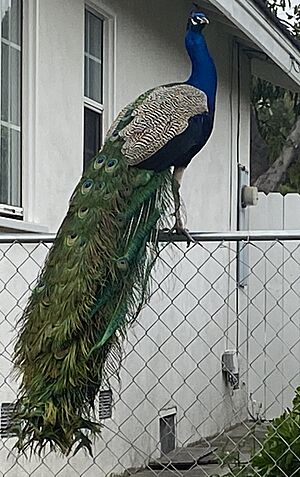
Los Angeles is a great place for birds, with over 500 different types recorded. The mild climate helps many kinds of animals and plants thrive, including those that have been brought from other places.
The county has many different natural areas, like mountains, wetlands, deserts, and the ocean. This means you can see many different kinds of animals in one day. For example, you might see desert bighorn sheep and green sea turtles without leaving the county.
Some native animals that show the health of the local environment include:
- Amphibians: Baja California chorus frog, black-bellied slender salamander, western toad.
- Birds: Acorn woodpecker, California quail, canyon wren, great blue heron, great horned owl, red-tailed hawk.
- Mammals: Bobcat, gray fox, mountain lion, mule deer.
- Reptiles: California kingsnake, coachwhip snake, gopher snake, western rattlesnake.
There are also at least 100 different types of trees and 1,000 types of non-native plants in the urban areas of the county.
Economy and Jobs
Los Angeles County is famous for its entertainment and digital media industries. All five major film studios are located here: Paramount Pictures, Sony Pictures, Warner Bros., Universal Pictures, and Walt Disney Studios.
But there are many other important industries too:
- International Trade: Supported by the Port of Los Angeles and the Port of Long Beach. These ports are very busy!
- Music: Recording and production.
- Aerospace and Defense: Making planes and defense equipment.
- Fashion: Designing and making clothes.
- Professional Services: Like law, medicine, engineering, and financial services.
Many big companies have their main offices in Los Angeles County. Some examples include:
- Beverly Hills: Live Nation Entertainment, Metro-Goldwyn-Mayer
- Burbank: Walt Disney Co, Warner Bros.
- El Segundo: Mattel (the toy company)
- Los Angeles: Universal Pictures, Herbalife
- Monrovia: Trader Joe's (grocery store)
- Santa Monica: Activision Blizzard (video games), Hulu (streaming), Snap Inc. (Snapchat)
- Torrance: American Honda Motor Co.
Education
Los Angeles County has many schools and colleges. The Los Angeles County Office of Education helps support the local school districts. The largest school district is the Los Angeles Unified School District. It runs public schools mainly within the city of Los Angeles.
Colleges and Universities
There are many colleges and universities in Los Angeles County, offering different types of studies. Some well-known ones include:
- California Institute of Technology (Caltech) in Pasadena
- California State University, Long Beach (CSULB)
- California State University, Los Angeles (CSULA)
- California State University, Northridge (CSUN)
- Loyola Marymount University (LMU) in Los Angeles
- Pepperdine University in Malibu
- University of California, Los Angeles (UCLA)
- University of Southern California (USC)
Fun Places to Visit
Los Angeles County has many exciting places to visit!
Parks and Outdoor Fun
- Griffith Park: A huge park in Los Angeles with trails and attractions.
- LA County Fair: An annual event in Pomona with rides, food, and exhibits.
- La Brea Tar Pits: A famous site where ancient animal fossils are found in tar.
- California Poppy Reserve: A beautiful place to see California's state flower bloom in spring.
- Castaic Lake: A large lake for water skiing and swimming.
- Santa Catalina Island: An island off the coast, great for exploring and enjoying nature.
Beaches and Coastal Areas
- Venice Beach: Known for its unique boardwalk and artistic vibe.
- Santa Monica Pier: A famous pier with a Ferris wheel and other rides.
- Malibu: A beautiful coastal city, home to many celebrities.
Museums and Learning Centers
- Academy Museum of Motion Pictures: Learn about the history of movies.
- California Science Center: Explore science and space, home to the Space Shuttle Endeavour.
- Los Angeles County Museum of Art: See amazing art from different times and places.
- Natural History Museum of Los Angeles County: Discover dinosaurs, animals, and natural history.
- J. Paul Getty Center and Getty Villa: Two art museums with beautiful architecture and gardens.
- Museum of Tolerance: Learn about human rights and history.
Entertainment and Music Venues
- Universal Studios Hollywood: A theme park based on movies.
- Six Flags Magic Mountain: A large amusement park with many roller coasters.
- Hollywood Bowl: A famous outdoor amphitheater for concerts.
- Walt Disney Concert Hall: A stunning building known for its unique design and music performances.
- Dodger Stadium: Home of the Los Angeles Dodgers baseball team.
- SoFi Stadium: A modern stadium for sports and concerts.
Getting Around Los Angeles County
Los Angeles County has many ways to travel, from highways to trains and airports.
Major Roads
The county has a big network of highways, often called "freeways" by locals. Some of the main ones include:
- Interstate 5 (I-5)
- Interstate 10 (I-10)
- Interstate 405 (I-405)
- U.S. Route 101 (US 101)
Airports
- Los Angeles International Airport (LAX): This is the main airport for flights in and out of the county.
- Long Beach Municipal Airport: Another important airport for commercial flights.
- Bob Hope Airport in Burbank: Serves Burbank, Glendale, and Pasadena.
There are also several smaller airports for private planes.
Trains
Los Angeles is a big center for moving goods by train, especially because of its large seaports.
- Amtrak: Provides long-distance passenger train service from Union Station in Los Angeles to cities like San Diego, Seattle, and Chicago.
- Metrolink: A commuter train service that connects Los Angeles to many other cities in the Greater Los Angeles Area.
- Los Angeles Metro Rail: This system includes light rail (street-level trains) and subway lines that help people travel within the county.
Seaports
The county has two major seaports:
- Port of Los Angeles
- Port of Long Beach
Together, these ports handle a huge amount of goods coming into the United States. They are the largest and most important ports in the country. The Port of Los Angeles is also the biggest cruise ship center on the West Coast.
Water Supply
Water in Los Angeles County comes from many different water districts. California has faced droughts, which means there isn't enough rain. These droughts make it harder to get enough water for everyone in the county.
Cities and Communities
Los Angeles County has 88 cities and many other communities. The largest city is Los Angeles.
Largest Cities by Population (2018 Estimate)
| City | Population |
|---|---|
| Los Angeles |
3,990,456
|
| Long Beach |
467,354
|
| Santa Clarita |
210,089
|
| Glendale |
201,361
|
| Lancaster |
159,053
|
| Palmdale |
156,667
|
| Pomona |
152,361
|
| Torrance |
145,182
|
| Pasadena |
141,371
|
| El Monte |
115,586
|
| Downey |
112,269
|
| West Covina |
106,311
|
| Norwalk |
105,120
|
| Burbank |
103,695
|
Other Communities
Los Angeles County also has many unincorporated areas, which means they are not part of an official city. Some of these are called Census Designated Places (CDPs) and have many residents. Examples include East Los Angeles, Hacienda Heights, and Altadena.
Images for kids
-
A view of the Los Angeles County Fair at dusk in 2008.
-
The Los Angeles County Museum of Art during an Ancient Egypt exhibit in 2005.
-
The unique design of the Walt Disney Concert Hall.
-
A view of Angeles National Forest.
See also
 In Spanish: Condado de Los Ángeles para niños
In Spanish: Condado de Los Ángeles para niños


